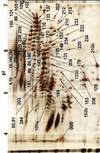Maternal serum proteome changes between the first and third trimester of pregnancy in rural southern Nepal
- PMID: 22385826
- PMCID: PMC4703092
- DOI: 10.1016/j.placenta.2012.02.009
Maternal serum proteome changes between the first and third trimester of pregnancy in rural southern Nepal
Abstract
Characterization of normal changes in the serum proteome during pregnancy may enhance understanding of maternal physiology and lead to the development of new gestational biomarkers. In 23 Nepalese pregnant women who delivered at term, two-dimensional difference in-gel electrophoresis (DIGE) was used to assess changes in relative protein abundance between paired serum samples collected in the first and third trimesters. One-hundred and forty-five of over 700 protein spots in DIGE gels (pI 4.2-6.8) exhibited nominally significant (p < 0.05) differences in abundance across trimesters. Additional filtering using a Bonferroni correction reduced the number of significant (p < 0.00019) spots to 61. Mass spectrometric analysis detected 38 proteins associated with gestational age, cytoskeletal remodeling, blood pressure regulation, lipid and nutrient transport, and inflammation. One new protein, pregnancy-specific β-glycoprotein 4 was detected. A follow-up isotope tagging for relative and absolute quantitation (iTRAQ) experiment of six mothers from the DIGE study revealed 111 proteins, of which 11 exhibited significant (p < 0.05) differences between trimesters. Four of these proteins: gelsolin, complement C1r subcomponent, α-1-acid glycoprotein, and α-1B-glycoprotein also changed in the DIGE analysis. Although not previously associated with normal pregnancy, gelsolin decreased in abundance by the third trimester (p < 0.01) in DIGE, iTRAQ and Western analyses. Changes in abundance of proteins in serum that are associated with syncytiotrophoblasts (gelsolin, pregnancy-specific β-1 glycoprotein 1 and β-2-glycoprotein I) probably reflect dynamics of a placental proteome shed into maternal circulation during pregnancy. Measurement of changes in the maternal serum proteome, when linked with birth outcomes, may yield biomarkers for tracking reproductive health in resource poor settings in future studies.
Published by Elsevier Ltd.
Figures



Similar articles
-
Proteomic analysis of first trimester maternal serum to identify candidate biomarkers potentially predictive of spontaneous preterm birth.J Proteomics. 2018 Apr 30;178:31-42. doi: 10.1016/j.jprot.2018.02.002. Epub 2018 Feb 13. J Proteomics. 2018. PMID: 29448056
-
Serum alpha-fetoprotein in the three trimesters of pregnancy: effects of maternal characteristics and medical history.Ultrasound Obstet Gynecol. 2015 Jul;46(1):34-41. doi: 10.1002/uog.14809. Epub 2015 May 25. Ultrasound Obstet Gynecol. 2015. PMID: 25652769
-
Serum free β-human chorionic gonadotropin in the three trimesters of pregnancy: effects of maternal characteristics and medical history.Ultrasound Obstet Gynecol. 2015 Jul;46(1):51-9. doi: 10.1002/uog.14869. Epub 2015 May 27. Ultrasound Obstet Gynecol. 2015. PMID: 25846870
-
Gestational age and maternal status of DHA and other polyunsaturated fatty acids in pregnancy: A systematic review.Prostaglandins Leukot Essent Fatty Acids. 2019 May;144:16-31. doi: 10.1016/j.plefa.2019.04.006. Epub 2019 Apr 18. Prostaglandins Leukot Essent Fatty Acids. 2019. PMID: 31088623
-
Obstetrical complications associated with abnormal maternal serum markers analytes.J Obstet Gynaecol Can. 2008 Oct;30(10):918-932. doi: 10.1016/S1701-2163(16)32973-5. J Obstet Gynaecol Can. 2008. PMID: 19038077 Review. English, French.
Cited by
-
Host immune status and response to hepatitis E virus infection.Clin Microbiol Rev. 2014 Jan;27(1):139-65. doi: 10.1128/CMR.00062-13. Clin Microbiol Rev. 2014. PMID: 24396140 Free PMC article. Review.
-
Comprehensive maternal serum proteomics identifies the cytoskeletal proteins as non-invasive biomarkers in prenatal diagnosis of congenital heart defects.Sci Rep. 2016 Jan 11;6:19248. doi: 10.1038/srep19248. Sci Rep. 2016. PMID: 26750556 Free PMC article.
-
Liquid phase based separation systems for depletion, prefractionation, and enrichment of proteins in biological fluids and matrices for in-depth proteomics analysis-An update covering the period 2011-2014.Electrophoresis. 2015 Jan;36(1):238-52. doi: 10.1002/elps.201400434. Epub 2014 Nov 24. Electrophoresis. 2015. PMID: 25287967 Free PMC article. Review.
-
Proteomic analysis of plasma total exosomes and placenta-derived exosomes in patients with gestational diabetes mellitus in the first and second trimesters.BMC Pregnancy Childbirth. 2024 Oct 30;24(1):713. doi: 10.1186/s12884-024-06919-9. BMC Pregnancy Childbirth. 2024. PMID: 39478498 Free PMC article.
-
Sex as an important factor in nanomedicine.Nat Commun. 2021 May 20;12(1):2984. doi: 10.1038/s41467-021-23230-9. Nat Commun. 2021. PMID: 34017011 Free PMC article. Review.
References
-
- Anderson NL, Polanski M, Pieper R, Gatlin T, Tirumalai RS, Conrads TP, Veenstra TD, Adkins JN, Pounds JG, Fagan R, Lobley A. The human plasma proteome: a nonredundant list developed by combination of four separate sources. Mol Cell Proteomics. 2004;3(4):311–326. - PubMed
-
- Hudler P, Gorsic M, Komel R. Proteomic strategies and challenges in tumor metastasis research. Clin Exp Metastasis. 2010;27(6):441–451. - PubMed
-
- Fu Q, Van Eyk JE. Proteomics and heart disease: identifying biomarkers of clinical utility. Expert Rev Proteomics. 2006;3(2):237–249. - PubMed
-
- Shankar R, Gude N, Cullinane F, Brennecke S, Purcell AW, Moses EK. An emerging role for comprehensive proteome analysis in human pregnancy research. Reproduction. 2005;129(6):685–696. - PubMed
-
- Christian P, West KP, Khatry SK, Leclerq SC, Pradhan EK, Katz J, Shrestha SR, Sommer A. Effects of maternal micronutrient supplementation on fetal loss and infant mortality: a cluster-randomized trial in Nepal. Am J Clin Nutr. 2003;78(6):1194–1202. - PubMed
Publication types
MeSH terms
Substances
Grants and funding
LinkOut - more resources
Full Text Sources
Other Literature Sources
Research Materials
Miscellaneous

